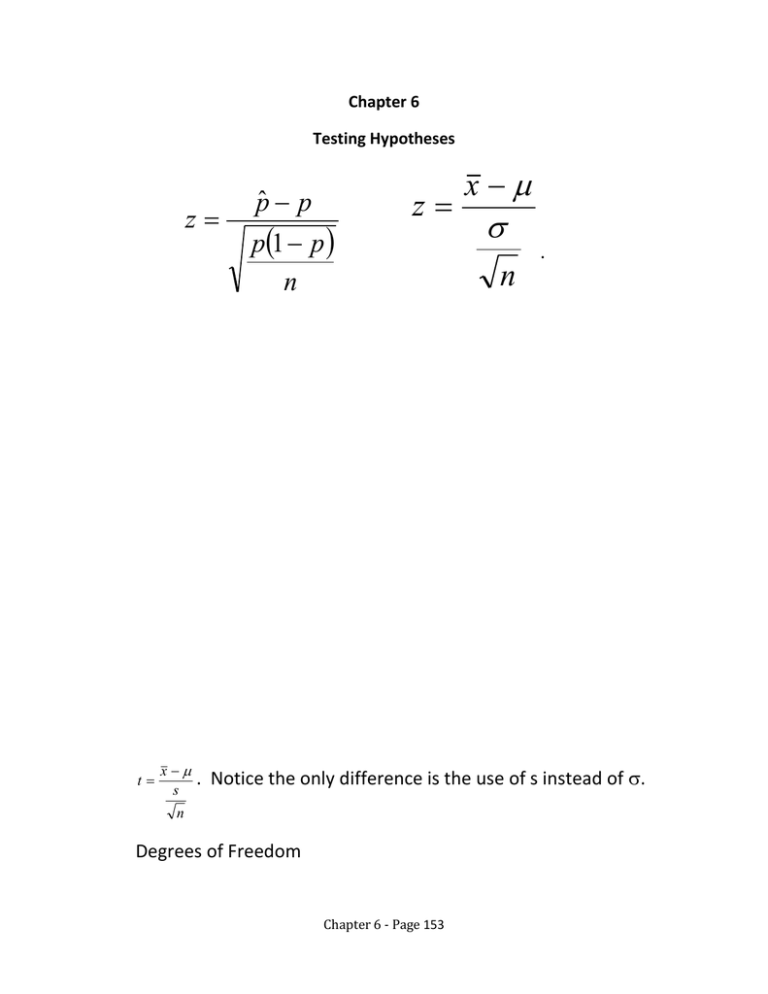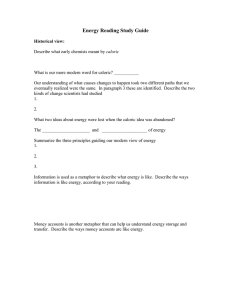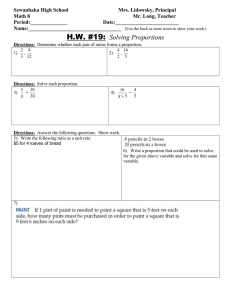advertisement

Chapter 6 Testing Hypotheses z t x s pˆ p p1 p n z x n . . Notice the only difference is the use of s instead of . n Degrees of Freedom Chapter 6 - Page 153 Student t distributions One Tail Probability 0.4 0.25 0.1 0.05 0.025 0.01 0.005 0.0005 Two Tail Probability 0.8 0.5 0.2 0.1 0.05 0.02 0.01 0.001 Confidence Level 20% 50% 80% 90% 95% 98% 99% 99.9% 0.325 0.289 0.277 0.271 0.267 0.265 0.263 0.262 0.261 0.260 0.260 0.259 0.259 0.258 0.258 0.258 0.257 0.257 0.257 0.257 0.257 0.256 0.256 0.256 0.256 0.256 0.256 0.256 0.256 0.256 0.255 0.254 0.254 0.253 1.000 0.816 0.765 0.741 0.727 0.718 0.711 0.706 0.703 0.700 0.697 0.695 0.694 0.692 0.691 0.690 0.689 0.688 0.688 0.687 0.686 0.686 0.685 0.685 0.684 0.684 0.684 0.683 0.683 0.683 0.681 0.679 0.677 0.674 3.078 1.886 1.638 1.533 1.476 1.440 1.415 1.397 1.383 1.372 1.363 1.356 1.350 1.345 1.341 1.337 1.333 1.330 1.328 1.325 1.323 1.321 1.319 1.318 1.316 1.315 1.314 1.313 1.311 1.310 1.303 1.296 1.289 1.282 6.314 2.920 2.353 2.132 2.015 1.943 1.895 1.860 1.833 1.812 1.796 1.782 1.771 1.761 1.753 1.746 1.740 1.734 1.729 1.725 1.721 1.717 1.714 1.711 1.708 1.706 1.703 1.701 1.699 1.697 1.684 1.671 1.658 1.645 12.706 4.303 3.182 2.776 2.571 2.447 2.365 2.306 2.262 2.228 2.201 2.179 2.160 2.145 2.131 2.120 2.110 2.101 2.093 2.086 2.080 2.074 2.069 2.064 2.060 2.056 2.052 2.048 2.045 2.042 2.021 2.000 1.980 1.960 31.821 6.965 4.541 3.747 3.365 3.143 2.998 2.896 2.821 2.764 2.718 2.681 2.650 2.624 2.602 2.583 2.567 2.552 2.539 2.528 2.518 2.508 2.500 2.492 2.485 2.479 2.473 2.467 2.462 2.457 2.423 2.390 2.358 2.326 63.656 9.925 5.841 4.604 4.032 3.707 3.499 3.355 3.250 3.169 3.106 3.055 3.012 2.977 2.947 2.921 2.898 2.878 2.861 2.845 2.831 2.819 2.807 2.797 2.787 2.779 2.771 2.763 2.756 2.750 2.704 2.660 2.617 2.576 636.578 31.600 12.924 8.610 6.869 5.959 5.408 5.041 4.781 4.587 4.437 4.318 4.221 4.140 4.073 4.015 3.965 3.922 3.883 3.850 3.819 3.792 3.768 3.745 3.725 3.707 3.689 3.674 3.660 3.646 3.551 3.460 3.373 3.290 df 1 2 3 4 5 6 7 8 9 10 11 12 13 14 15 16 17 18 19 20 21 22 23 24 25 26 27 28 29 30 40 60 120 z* Chapter 6 - Page 154 Use the table to find a p-value. You will use inequality signs to show the p-value with as much precision as possible, compared with alpha. 1. H1: > = 0.05 df = 12, t = 1.9 2. H1: ≠ = 0.01 df = 25, t = -1.1 The four hypothesis-test formulas that will be shown in this chapter will be illustrated with these five questions. As you read the questions, try to determine any similarities or differences between them, as that will ultimately guide you into which formula should be used. Are more than 10% of households prepared for a natural disaster? Is there a difference between the proportion of households in tornado/hurricane areas prepared for a disaster and the proportion of households in earthquake areas? Is the average daily caloric intake of US residents greater than 3000 kcal? Is the average daily caloric intake of Canadian residents less than the average daily caloric intake of Americans? Is there a significant difference between the average daily caloric intake of a person on a diet compared to prior to the diet? Chapter 6 - Page 155 Question Parameter Populati Hypotheses ons Are more than 10% of households prepared for a natural disaster? Is there a difference between the proportion of households in tornado/hurricane areas prepared for a disaster and the proportion of households in earthquake areas? proportion 1 H0: P = 0.1 H1: P > 0.1 proportion 2 H0: PT = PE H1: PT ≠PE 1 H0: µ = 3000 H1: µ > 3000 1 H0 : µ = 0 H1 : µ ≠ 0 2 H0: µ Canadian = µ Is the average daily caloric mean intake of US residents greater than 3000 kcal? Is there a significant mean difference between the average daily caloric intake of a person on a diet compared to prior to the diet? Is the average daily caloric mean intake of Canadian residents less than the average daily caloric intake of Americans? . Chapter 6 - Page 156 American H1: µ Canadian < µ American For Categorical Data Normal Approximation to Binomial X XXX XXXXX µ =np. npq . z x . p̂ p̂ p̂ p̂ p̂ p̂ p̂ p̂ p̂ pˆ p pˆ p1 p . n z pˆ p p1 p n . Chapter 6 - Page 157 x x x x x x x x x x x n . z x . Because is not known, it is estimated n with s, so that the estimated standard error is is replaced by the t formula where t x s sx s n and the Z formula . n Assumptions for the remaining formulas that will not be proved 1. The mean of the difference of two random variables is the difference of the means. 2. The variance of the difference of two independent random variables is the sum of the variances. 3. The difference of two independent normally distributed random variables is also normally distributed.1 1 Aliaga, Martha, and Brenda Gunderson. Interactive Statistics. Upper Saddle River, NJ: Pearson Prentice Hall, 2006. Print. Chapter 6 - Page 158 Is there a difference between the proportion of households in tornado/hurricane areas prepared for a disaster and the proportion of households in earthquake areas? This means that there are two populations, the population in tornado/hurricane country and earthquake country. Within each population, the proportion of people who are prepared will be found. The hypotheses are: H0: PT = PE H1: PT ≠PE H0 : P T – P E = 0 H1: PTe – PE ≠ 0 Since neither PT or PE is known because these are parameters, the best that can be done is estimate them using sample proportions. Therefore p̂T will be used as an estimate of PT and p̂E will be used as an estimate of PE. Then pˆ T pˆ E as an estimate for PT – PE. The distribution of interest to us is the one consisting of the difference between sample proportions, generically shown as pˆ A pˆ B . pˆ A pˆ B pˆ A pˆ B pˆ A pˆ B pˆ A pˆ B Chapter 6 - Page 159 The mean of this distribution is pA – pB and the standard deviation is p A 1 p A p B 1 p B . Since the only thing that is known nA nB about pA and pB is that they are equal, it is necessary to estimate their value so that the standard deviation can actually be computed. To do this, the sample proportions will be combined. The combined proportion is defined as pˆ c Replacing pA and pB with standard error of p̂ c x A xB n A nB . results in the formula for estimated pˆ c 1 pˆ c pˆ c 1 pˆ c or nA nB 1 1 . pˆ c 1 pˆ c n n B A We can now substitute into the z formula, z x to get the test statistic used when testing the difference between two population proportions, z pˆ A pˆ B p A p B . 1 1 pˆ c 1 pˆ c n A nB For this test statistic, both sample sizes should be sufficient large (n>20) with a minimum of 5 successes and 5 failures. Chapter 6 - Page 160 A similar approach will be taken with question 4, which asks: Is the average daily caloric intake of Canadian residents less than the average daily caloric intake of Americans? There are two populations being compared, the population of Canadians and the population of Americans. The average amount of exercise in each of these populations will be compared. When the means of two populations are compared, the hypotheses are written as: H0 : µ C = µ A H1 : µ C < µ A H0 : µ C – µ A = 0 H1 : µ C – µ A < 0 Since n either µ C or µA are known because these are parameters, the best that can be done is to estimate them using sample means. Therefore xC will be used as an estimate of µ C and xA will be used as an estimate of µ A. Then xC x A is an estimate for µ C – µ A. The distribution of interest to us is the one consisting of the difference between sample means, generically shown as x A xB . x A xB x A xB x A xB x A xB Chapter 6 - Page 161 The mean of this distribution is µ A – µ B and the standard deviation is A2 nA B2 nB . Once again we run into the problem that the standard deviation of the populations A and B are not known, so they must be estimated with the sample standard deviation sA and sB. An additional problem is that it is not known if the variances for the two populations are equal (homogeneous). Unequal variances (heterogeneous) increase the Type I error rate.2 The t Test for Two Independent Samples is used to test the hypothesis. This test is dependent upon the following assumptions. 1. Each sample is randomly selected from the population it represents. 2. The distribution of data in the population from which the sample was drawn is normal 3. The variances of the two populations are equal. This is the homogeneity of variance assumption. 3 2 Sheskin, David J. Handbook of Parametric and Nonparametric Statistical Procedures. Boca Raton: Chapman & Hall/CRC, 2000. Print. 3 Sheskin, David J. Handbook of Parametric and Nonparametric Statistical Procedures. Boca Raton: Chapman & Hall/CRC, 2000. Print. Chapter 6 - Page 162 The test statistic follows the same basic pattern as the other tests, which involves finding the number of standard errors a statistic is away from the hypothesized parameter. t x A x B A B s12 s 22 n1 n 2 The assumption with this formula is that the two sample sizes are equal. If this formula is used when the sample sizes are not equal, there is an increased chance of making a Type I error. In such cases, an alternative formula is used which includes the weighted average of the estimated population variances of the two groups. The weighted average is based on the number of degrees of freedom in each sample. This formula can be used for both equal and non-equal sample sizes. t x A x B A B n A 1s A2 n B 1s B2 1 n A nB 2 1 n n B A Because two parameters (A and B) are replaced by sA and sB, two degrees of freedom are lost. Thus, the number of degrees of freedom for this test statistic is n1+n2 – 2. Chapter 6 - Page 163 There are four different hypothesis tests presented in this chapter. The hypotheses and test statistics are summarized in the following table. 1 – sample Proportions (for categorical data) Means (for quantitative data) H0: p = p0 H1: p < p0 or p > p0 or p ≠ p0 H0: = 0 H1: < 0 or > 0 or ≠ 0 z pˆ p t p1 p n x s n Assumptions: df = n – 1 np 5, n(1-p) 5 Assumptions: If n<30, population is approximately normally distributed. 2 – samples H0: p A = p B H1: p A < p B or p A > p B or p A ≠ p B z pˆ A pˆ B p A p B 1 1 pˆ c 1 pˆ c n A nB where pˆ c x A xB n A nB H0: µ A = µ B H1: µ A < µ B or µ A > µ B or µ A ≠ µ B t x A x B A B n A 1s A2 n B 1s B2 1 n A nB 2 1 n n B A df = nA+nB – 2 Assumptions: If n<30, population is approximately normally distributed. For each hypothesis-testing situation, you will have to decide which formula and which table to use. Notice that when the hypotheses are about proportions, the standard normal z distribution is used. When the hypotheses are about means, the t distributions are used. Chapter 6 - Page 164 We will now return to our original five questions. The statistics given in these problems are fictitious. 1. Are more than 10% of households prepared for a natural disaster? Assume that a random sample of 900 households was taken. Of these, 98 claimed they are prepared. Can we conclude that more than 10% are prepared? Use a level of significance of 0.05. The hypotheses are: H0: P = 0.1 H1: P > 0.1 Show the problem and write a concluding sentence. Chapter 6 - Page 165 2. Is there a difference between the proportion of households in tornado/hurricane areas prepared for a disaster and the proportion of households in earthquake areas? Assume a random sample is taken from both populations. For the Tornado country 122/800 are prepared. For earthquake country, 98/900 are prepared. Chapter 6 - Page 166 3. Is the average daily caloric intake of US residents greater than 3000 kcal? Mean 3250, SD 600 n = 18 Chapter 6 - Page 167 4. Is there a significant difference between the average daily caloric intake of a person on a diet compared to prior to the diet? Subject 1 2 3 4 5 6 Before 3820 3550 2840 4280 2960 2540 calories during 3760 3650 2530 3460 2960 2530 calories duringBefore -60 100 -310 -820 0 Chapter 6 - Page 168 -10 5. Is the average daily caloric intake of Canadian residents less than the average daily caloric intake of Americans? H0: µ Canadian = µ American H1: µ Canadian < µ American The table below shows the mean, standard deviation and sample size for the two samples. Units: hours/week Canadians Americans Mean 2950 3250 Standard Deviation 550 600 sample size, n 14 18 Chapter 6 - Page 169 All of these tests can be done using the TI84 calculator. The tests are found by selecting the STAT key and then using the cursor arrows to move to the right to TESTS. 1 – sample 2 – samples Proportions (for categorical data) Means (for quantitative data) H0: p = p0 H1: p < p0 or p > p0 or p ≠ p0 H0: = 0 H1: < 0 or > 0 or ≠ 0 Test 5: 1-PropZTest Test 2: T-Test H0: p A = p B H1: p A < p B or p A > p B or p A ≠ p B H0: µ A = µ B H1: µ A < µ B or µ A > µ B or µ A ≠ µ B Test 6: 2-PropZTest Test 4: 2-SampTTest Chapter 6 - Page 170

